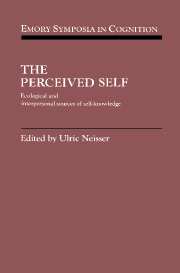Book contents
- Frontmatter
- Contents
- Preface
- List of contributors
- Part I Introduction
- Part II The concept of an ecological self
- 2 Ontogenesis of the perceived self
- 3 Body–environment coupling
- 4 A theory of representation-driven actions
- 5 The ecological self in historical context
- 6 Good intentions and dancing moments: Agency, freedom, and self-knowledge in dance
- 7 The primacy of the ecological self
- Part III The interpersonal self and its implications
- Author index
- Subject index
4 - A theory of representation-driven actions
Published online by Cambridge University Press: 29 March 2010
- Frontmatter
- Contents
- Preface
- List of contributors
- Part I Introduction
- Part II The concept of an ecological self
- 2 Ontogenesis of the perceived self
- 3 Body–environment coupling
- 4 A theory of representation-driven actions
- 5 The ecological self in historical context
- 6 Good intentions and dancing moments: Agency, freedom, and self-knowledge in dance
- 7 The primacy of the ecological self
- Part III The interpersonal self and its implications
- Author index
- Subject index
Summary
The aim of this chapter is to develop the idea that an important part of human action is driven by internal rather than external factors. The basic postulates are that internally driven actions result from autonomous processes, that they are based on representations that anticipate the effects of interaction of the self with the external milieu, and finally, that they play an important role in structuring the self. The first part of the chapter presents a brief historical account of the notions of intention and representation as envisioned in the context of the generation and control of actions. A second part is devoted to exploring the field of mental imagery, which represents a new approach to representational phenomena. Finally, the third part deals with the nature of representational systems that may account for producing voluntary action.
The neurophysiological correlates of intention
What are the respective roles of stimulus-driven and representation-driven actions in structuring our knowledge about the external world? The issue is at the core of a long-lasting debate between two schools of thought. I will call centralist the school that holds that experience and knowledge grow from actions that are the expression of a mental content.
- Type
- Chapter
- Information
- The Perceived SelfEcological and Interpersonal Sources of Self Knowledge, pp. 68 - 88Publisher: Cambridge University PressPrint publication year: 1994
- 1
- Cited by



